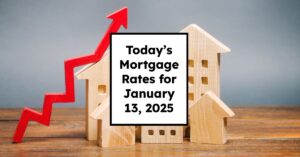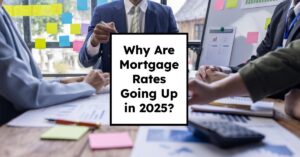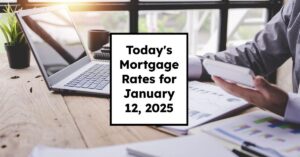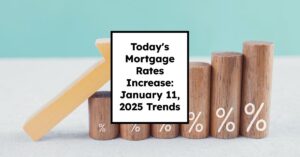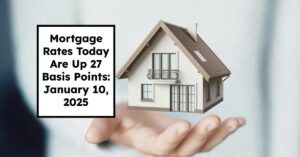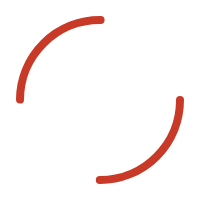When it comes to buying a home or refinancing an existing mortgage, today's mortgage rates play a critical role in shaping your financial decisions. As of January 13, 2025, mortgage rates have seen a noticeable uptick, with the average 30-year fixed rate at 6.78% and the 15-year fixed rate at 6.07%, according to Zillow. These rates reflect ongoing economic concerns, particularly inflation, which could continue to influence trends throughout the year.
Today’s Mortgage Rates for January 13, 2025: Trends & Insights
Key Takeaways
- Current Averages:
- 30-Year Fixed Rate: 6.78%
- 15-Year Fixed Rate: 6.07%
- 5/1 ARM: 7.16%
- Refinance Rates: Generally higher than purchase rates, with the 30-year fixed refinance at 6.84%.
- Debt Considerations: Higher rates can mean paying more in interest over the life of your loan.
- Buyers Beware: Economic factors, such as inflation and federal policies, prolong high mortgage rates.|
Understanding Mortgage Rates Today
Understanding today's mortgage rates involves considering various terms, types, and current national trends. The 30-year fixed mortgage is often the most popular choice for homebuyers due to its long repayment term, which allows for lower monthly payments compared to shorter-term loans.
As illustrated earlier, the current rate for a 30-year mortgage stands at 6.78%, an increase of 11 basis points from the previous week. This means that if you take out a $300,000 mortgage at this rate, your expected monthly payment for principal and interest would be approximately $1,952. Over the life of the loan, you would end up paying a staggering $402,641 in interest in addition to the original mortgage amount.
Conversely, the 15-year mortgage is a more aggressive option that allows borrowers to pay off their loans much sooner, with a current average interest rate of 6.07%. Although this results in a significantly lower overall interest payment of about $157,727 over the life of a $300,000 loan, the monthly payment would rise to around $2,543. This jump is due to the loan being paid off in half the time, which can strain monthly budgets but significantly saves on long-term interest costs.
| Type | Current Rate | Monthly Payment (on $300,000) | Total Interest Paid |
|---|---|---|---|
| 30-Year Fixed | 6.78% | $1,952 | $402,641 |
| 15-Year Fixed | 6.07% | $2,543 | $157,727 |
| 5/1 ARM | 7.16% | Varies (Fixed for 5 years) | Varies |
Adjustable-Rate Mortgages (ARMs)
Another option on the market includes Adjustable-Rate Mortgages (ARMs), which come with a fixed interest rate for a set period before adjusting periodically. The most common type, the 5/1 ARM, currently stands at 7.16%. This rate is locked in for the first five years, after which it can increase or decrease annually. The appeal here lies in the initial lower rates, which can make homeownership more affordable initially. However, potential buyers must weigh the risk of future increases in their monthly payments once the fixed period ends.
| ARM Type | Current Rate | Payment Variability |
|---|---|---|
| 5/1 ARM | 7.16% | Fixed for 5 years, then variable |
| 7/1 ARM | 7.08% | Fixed for 7 years, then variable |
Refinance Trends
For those considering refinancing an existing mortgage, it’s essential to know the latest rates. Currently, the 30-year fixed refinance rate is at 6.84%, while the 15-year fixed refinance rate sits at 6.15%. Typically, these rates are slightly higher than the purchase rates due to additional risk factors involved in refinancing transactions.
| Type | Current Refinance Rate | Monthly Payment (on $300,000) |
|---|---|---|
| 30-Year Fixed Refinance | 6.84% | Approx. $1,965 (total interest varies) |
| 15-Year Fixed Refinance | 6.15% | Approx. $2,517 (total interest varies) |
| 5/1 ARM Refinance | 7.50% | Varies, potentially lower than fixed rates |
Recommended Read:
Mortgage Rate Predictions January 2025: Forecast for Homebuyers
Mortgage Rates for January 12, 2025: Trends & Insights
Mortgage Rates Rise to the Highest Level Since July Last Year
Factors Influencing Mortgage Rates
Several external factors contribute to the daily fluctuations in mortgage rates. As the financial landscape considers recent policies, such as those regarding inflation, the Federal Reserve's decisions become paramount. Current discussions around tariffs and their impact on inflation could prompt the Fed to maintain or even raise the federal funds rate later this year, which in turn influences mortgage rates.
Economic Conditions
The broader economic situation can significantly impact mortgage rates. When the economy is strong, consumer confidence rises. Individuals may decide to purchase homes, thus increasing demand. Increased demand for homes often drives prices—and subsequently interest rates—higher. Conversely, when demand is low, like during economic slowdowns or uncertainties, mortgage rates may decrease as lenders compete for fewer customers.
In recent years, fluctuations in inflation rates have also played a crucial role in setting the stage for mortgage rates. According to economic experts, high inflation signals an economy that may be overheating, prompting the Federal Reserve to impose tighter monetary policies, which typically includes raising interest rates. As inflation rates surge, potential homebuyers are faced with the likelihood of enduring expanded mortgage costs, further complicating the path to home ownership.
Current Economic Context
As speculated, former President Trump's tariff policies may influence inflation rates this year, which could cause the Federal Reserve to reconsider its strategy concerning federal funds rate cuts. The expected economic climate seems to correlate with predictions for the remainder of 2025, which suggests consumers might be better off buying sooner rather than later.
Homebuyer Sentiment
Moreover, potential homebuyers may be influenced by sentiment in the market. As reports indicate an ongoing rise in today's mortgage rates, many individuals may feel they should hold off until rates drop. However, a continual wait for a more favorable mortgage climate could lead buyers to miss out on homes they can afford right now.
In a recent survey, over 60% of potential homebuyers indicated they would rather purchase a home at a slightly higher interest rate than continue waiting indefinitely. This anxiety does not stem merely from current mortgage figures; it also reflects changing market dynamics, including rising property values and decreased housing supply due to a higher barrier to entry presented by these rising rates.
Impact on the Housing Market
The elevation of mortgage rates is expected to impact the housing market significantly. For instance, the increase in home loan costs could deter first-time homebuyers from entering the market, which in turn can create a cycle where demand diminishes. This situation could lead to stagnation in home sales, further influencing market conditions.
Over the past few months, many homebuilders have noted challenges in attracting buyers, as higher mortgage rates conflict with the first-time homebuyer demographic. However, as seasoned buyers recognize the correlation between current rates and the likelihood of securing their ideal home, we may see a ramp-up in market activity.
Long-term Considerations
As a potential buyer or homeowner, consider not only the current rates but also how those rates might affect your financial picture in the long run. If you secure a mortgage at 6.78% now and the rate does creep up to 7.5% or higher later this year, you could be looking at substantial savings.
The Time to Buy?
Many financial analysts suggest prospective buyers evaluate their individual circumstances and act. With projections indicating that high mortgage rates might persist throughout the year, the reality is that waiting could be more detrimental to a potential buyer's goals. Furthermore, as housing inventory remains relatively scarce, any postponement could pile on competition and escalate home prices, further complicating prospective acquisitions.
So, if you're waiting for mortgage rates to stabilize or drop, it might be wise to act now. Buying a home is not purely a function of securing the lowest possible rate; it's also about aligning your financial wellness with market realities.
Summary:
As we navigate through January 2025, the landscape of mortgage rates presents both challenges and opportunities for homebuyers and refinancers. A clear understanding of today's mortgage rates, alongside an informed vision of the economic implications, empowers individuals to make thoughtful financial decisions. Whether you are looking at a long-term investment or simply trying to leverage current rates, knowledge is power in the homebuying process.
Work with Norada in 2025, Your Trusted Source for
Real Estate Investing
With mortgage rates fluctuating, investing in turnkey real estate
can help you secure consistent returns.
Expand your portfolio confidently, even in a shifting interest rate environment.
Speak with our expert investment counselors (No Obligation):
(800) 611-3060
Recommended Read:
- Why Are Mortgage Rates Going Up in 2025: Will Rates Drop?
- Why Are Mortgage Rates So High and Predictions for 2025
- NAR Predicts 6% Mortgage Rates in 2025 Will Boost Housing Market
- Mortgage Rates Predictions for 2025: Expert Forecast
- Will Mortgage Rates Ever Be 3% Again: Future Outlook
- Mortgage Rates Predictions for Next 2 Years
- Mortgage Rate Predictions for Next 5 Years
- Mortgage Rate Predictions for 2025: Expert Forecast
- Mortgage Rate Predictions: Why 2% and 3% Rates are Out of Reach
- How Lower Mortgage Rates Can Save You Thousands?
- How to Get a Low Mortgage Interest Rate?
- Will Mortgage Rates Ever Be 4% Again?
